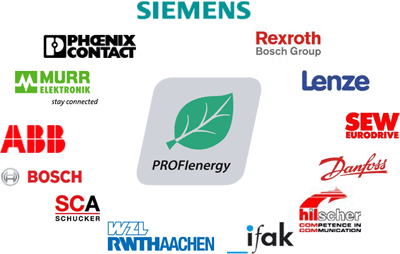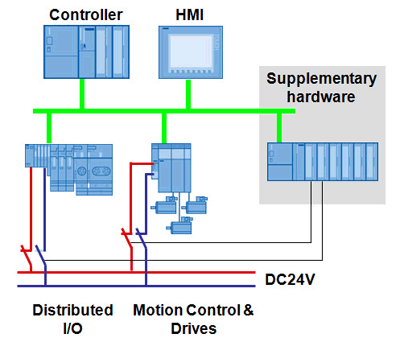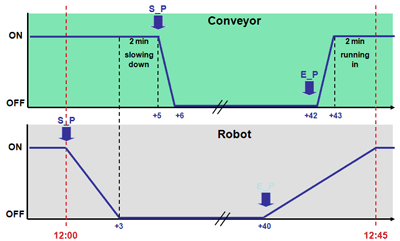
Introducing PROFIenergy: Control energy consumption with PROFINET
January 14, 2010
By Profibus Trade Organization
There’s nothing new about cutting energy consumption. Plant managers have been trying to do it forever; automation users are achieving it where they can but with varying degrees of success. The trouble is there’s never been a consistent, standardized approach for automation users to take. No single direction in which everyone — vendors and users — can focus.
The idea for a standardized energy management strategy sprang from the AIDA group in Germany, composed of Audi, BMW, Mercedes, Porsche and VW. Their energy consumption is eye-wateringly high. Think about all those robot cells… all those powerful motors, drives and lasers… all those paint lines and metal presses… everything.
AIDA companies collaborate in areas of common interest, generally related to manufacturing technologies. For example, several years ago they agreed on a single industrial Ethernet (PROFINET as it happens) as their preferred approach to next-generation networking in an effort to eliminate the “choices” that arose from earlier Fieldbus experiences.
Energy is one of the biggest costs in automotive manufacturing. It’s also under various pressures, such as security of supply. Governments are becoming concerned about climate change and are calling on manufacturing industries to reduce their carbon footprint. “Could there be a special profile of PROFINET that might standardize an approach to energy saving?” AIDA asked. Would PI, with its multi-vendor support and vast experience of developing automation standards, be willing to help?
 The response was immediate. A PI Working Group was set up early in 2009 and a specification is now nearing completion. Its supporters are shown in the image at the left: a mix of vendors, OEMs and service suppliers. Once the specification is approved (expected in early 2010), first products are likely to follow quickly.
The response was immediate. A PI Working Group was set up early in 2009 and a specification is now nearing completion. Its supporters are shown in the image at the left: a mix of vendors, OEMs and service suppliers. Once the specification is approved (expected in early 2010), first products are likely to follow quickly.
PROFIenergy outline
PROFIenergy is an application profile of PROFINET. In essence, it relies on the collaboration of three automation elements: the controlling device of an automation network (usually a PLC, but it could be a higher level supervisory system), the network itself (in this case PROFINET), and the Energy Consuming Unit, or ECU (which could be a single piece of equipment, or even a production cell). It’s the interaction of these three elements that makes PROFIenergy so powerful.
The role of PROFINET is simple: to transmit a set of standardized commands to the ECU under guidance from the controller device, and to receive back, when required, measurement data concerning energy consumption. It does this using the acyclic sections of the PROFINET protocol and therefore does not interfere with normal automation processes. Then, by intelligently switching off unnecessary ECUs, energy demand can be reduced.
 Why has this not been done before?
Why has this not been done before?
Well it has … but half-heartedly. During the idle period of a weekend, for example, ECUs can often consume about 60 percent of the energy used during production. These consumers are typically not switched off, usually because additional hardware has to be installed outside the machine to do this (see diagram to the left) and users are reluctant to put in the extra engineering effort. Further, such installations are usually proprietary and always hard-wired. To make things worse, a complete manual switch-off by disconnecting the power is about the most that can be achieved. Nothing about the system itself, or the interdependencies between its components, can be taken into account.
Understandably, crude, expensive and hard-to-manage systems like these are not popular. PROFIenergy, by contrast, requires no additional wiring or hardware since it allows energy demand to be managed over the existing PROFINET cables. PROFIenergy thus delivers a common solution that vendors and users can support together, delivering all the benefits of ‘openness’ that we are familiar with.
How does it work?
PROFIenergy functions and the switching mechanisms reside inside the ECUs themselves as function blocks. The network controller sends data to the ECUs stating when production pauses or stops will happen. These can be at pre-determined times, or they can be dictated by circumstances. It is then up to the ECU to decide how this information is handled. Software “agents” within each ECU react to the “start pause” and “end pause” times to initiate the actions required to reduce power consumption.
 Incorporating PROFIenergy’s functionality in end devices means that OEMs and vendors themselves decide how to optimize the energy management strategy. This recognizes that vendors probably understand better than anyone exactly what is the right course of action to take for particular combinations of equipment and pause times. Perhaps a drive can be run down to idle over a 30-second period, or perhaps a production cell requires that a conveyor be slowed first before a robot can be put into sleep mode. If the duration of a pause is long enough, perhaps the ECU can be completely disconnected … but held ready for instant restart so long as its conveyor is re-started far enough in advance. This is illustrated at the left
Incorporating PROFIenergy’s functionality in end devices means that OEMs and vendors themselves decide how to optimize the energy management strategy. This recognizes that vendors probably understand better than anyone exactly what is the right course of action to take for particular combinations of equipment and pause times. Perhaps a drive can be run down to idle over a 30-second period, or perhaps a production cell requires that a conveyor be slowed first before a robot can be put into sleep mode. If the duration of a pause is long enough, perhaps the ECU can be completely disconnected … but held ready for instant restart so long as its conveyor is re-started far enough in advance. This is illustrated at the left
Further possibilities are opened up if PROFIenergy’s ability to measure actual consumption and feed that back to the controller can somehow be integrated into an energy-management architecture. In this way PROFIenergy can even permit the use of a load-dependent machine control systems and help avoid peak load conditions.
Real-world situations
PROFIenergy use cases (UC) have been defined in collaboration with end users. They serve as the basis for the PROFIenergy specification:
• Brief pauses: The system selectively stops the equipment, such as during lunch breaks, and switches off those ECUs that will save energy during brief periods but that can be powered up again on time. Accordingly, only individual devices or equipment components are addressed. Important safety-related functions are retained. When production operation starts, the system activates the consumers in a defined switch-on sequence and checks whether all consumers have started up correctly. The system then starts the production process.
• Switching off and on during long pauses: This use case is very similar to the first one. Because the pause is longer, however, additional devices can be switched off, and the devices internally switch off more consumers.
• Switching off and on during unscheduled pauses: In contrast to the two previous cases, the pause timing and duration are unknown. Interruptions due to equipment malfunctions are a typical example of this. For this reason, the energy demand is reduced initially as if for a brief pause. If it turns out that the repair work will take longer, the possibility exists to place the equipment into an even more energy-saving state.
• Acquiring measurement data: An additional use case is the acquisition of measurement data from the ECU, either directly or implicitly. Frequency converters are an example of this implementation.
PROFIenergy requires only a simple set of commands to be used and, at the entry level where most PROFIenergy systems are likely to fit in the short term, the controls engineer has little additional work. Strict separation between the actual control logic of the process and the energy management system is maintained.
To take into account the user’s desire for upgradability and compatibility, PROFIenergy commands have been mapped onto existing PROFINET acyclic services, which do not occupy additional addresses in the process image. So, the volume of user data in a PROFINET device is not altered and the new PROFIenergy commands can be used in existing program libraries without repercussion. Likewise, device manufacturers can use a firmware update to expand their existing components to include the new functionality. This enables fast implementation, even in existing products.
Lifecycle value-added benefits
PROFIenergy provides an economical solution since the switching functions are integrated in devices. The separation of energy management and control functions means both parts of the program can be tested and commissioned independently. Structured programming greatly simplifies the updating and maintenance of the user program over the long term. PROFIenergy guarantees a uniform interface for energy management. The user can look for the device that is best suited to his application and which saves the most energy. The end user benefits from the competition among device manufacturers and system manufacturers to create value-added energy-saving solutions. With consumer pull and vendor push in conjunction and the cost saving potential so obvious, it’s likely that PROFIenergy will take off fast during 2010.
The Profibus Trade Organization (PTO) can be found at http://ca.profinet.com.